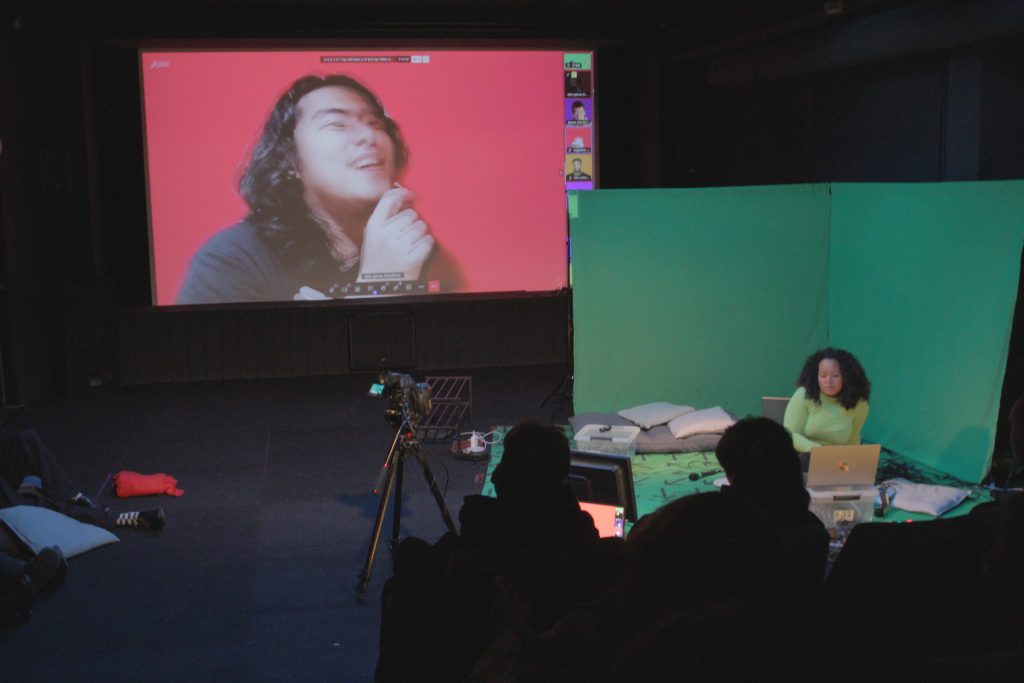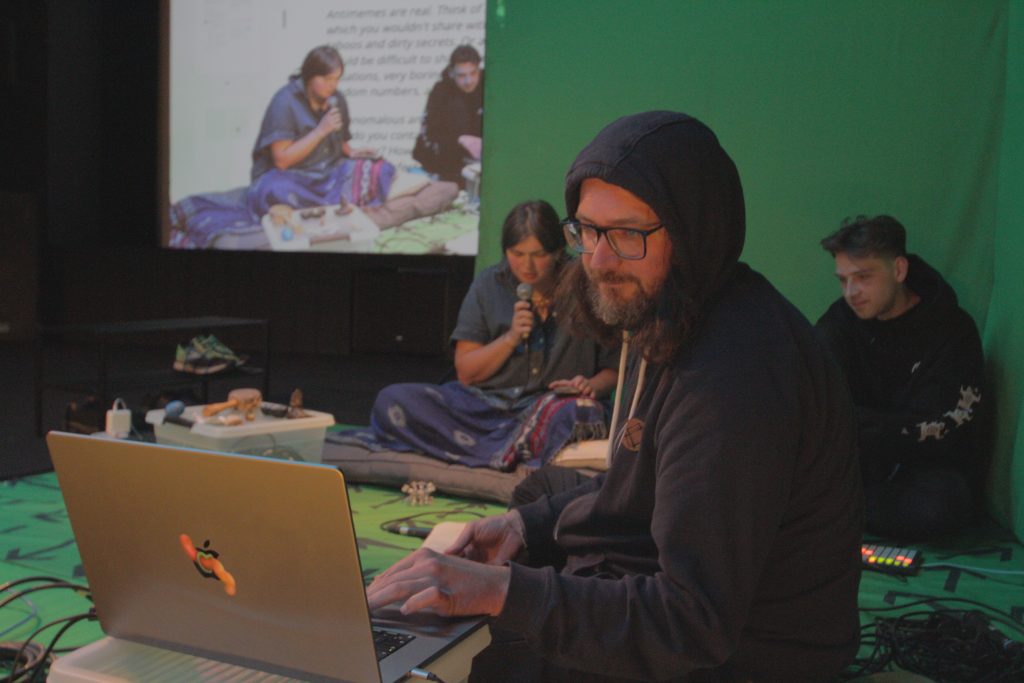This is a report and expanded publication based on the event "Expanded Publishing Fest #2: Space-in / Space-out", co-organized by Gytis Dovydaitis, Nero Editions, and The Insitute of Network Cultures. The event took place on April 19th 2024 at OT301 in Amsterdam and is part of a series of event in the context of the European project .expub.
Table of Content
Introduction
Chapter 1: Geographical
Chapter 2: Social
Chapter 3: Mental
Chapter 4: Virtual
Chapter 5: Material
Expansion 1: Club Night
Expansion 2: Book Fair
Colophon

I have lost my keys in cyberspace and now I can’t enter my house.
I spilled that digital porridge and my computer stopped working.
My metaverse shoes got drenched and now I’m nearing hypothermia.
Introduction
With Gytis Dovydaitis from 3022, Marta Ceccarelli from Nero Editions, Tommaso Campagna and Jordi Viader Guerrero from INC
Our internet-connected devices hold an unprecedented power to multiply us into a manifold of realities. The conventional way to conceptualise this is segregational – we “space-out” and we’re at cyberspace. However, as Heidegger noticed, one of the essential spatial practices of living beings is coming-into-nearness: “spacing-in”. Adding Lefebvre, the space that we space-out and space-in is a social product: not simply an element or sphere within which the social operates, but rather the expression of it. It’s a multitude of connections, flows of communication and capital, conditioned by politics and economic relationships, defined by class struggles, represented by those in power, lived by those who are subject to that power. The complex composite of ontologies that are unified within the internet are territories where cables and devices are juxtaposed with class struggle, virtual internet protocols, geopolitics and human cognition. The escapist “spacing-out” is only one part of the picture. Let’s space-in.
Task: to investigate the internet from a spatial perspective.
Question: what is that “space” in “cyberspace”?
Tentative answer: it’s complicated.
Methods of inquiry: performances, music, talks.
The first part of the event was curated by Gytis Dovydaitis in collaboration with Rūta Petrauskaitė and THE VOID. It follows the structure of cyberspatiality that emerged through his PhD work, presenting both discursive and performative investigations.
Geographical
Conversation with Sarah Vorndran from the Critical Infrastructure Lab
We begin with the geographical domain. This is where the ultimate physical territories and cyberspace infrastructure converge. This domain is characterized by its connection to the Earth’s surface, encompassing physical territories and human bodies. It is tangible and can be measured by Cartesian coordinates like XYZ, but can’t be directly observed when using internet-enabled devices. Interfaces keep the geography hidden. The essential function of this domain is territorializing the cyberspace within the physical and geopolitical landscapes of the Earth. Here lies both the environmental impact of cyberspace and disparities in access or types of infrastructures that are defined by political ideologies. Sarah Vorndran coming from Critical Infrastructure Lab delved deeper into this domain by presenting their research on the ideologies of network infrastructures.

Social
“The Square”, hybrid performance directed by Augustas Lapinskas from 3022
Cast: Alec Garcia [RED], Elie Lomami [ORANGE], Shivani Shah [YELLOW], Cyan D’Anjou [GREEN], Pritha K. [BLUE], Annan Zuo [Indigo], Letta Shtohryn [Violet]
Social domain encompasses the abstract and dynamic interactions among social individuals. It can’t be quantified on a Cartesian plane and involves human beings as social actors rather than bodies. Communication plays a central role here, mediating social processes and contributing to the formation of socially real objects such as hierarchies, trust, cultures, and power dynamics. Through trust-based communication, social domain serves it’s essential function by producing the cyberspace. The inequalities and power dynamics present in physical space are mirrored and sometimes intensified in cyberspace, making it more than just a physical infrastructure but a socially constructed space that is ubiquitously embedded in the contemporary social fabric. This is investigated by an online performance “The Square”, directed by Augustas Lapinskas and performed by 7 performers from all around the world.

Mental
“Disruption Scroll”, guided meditation by Adomas Lapinskas, Justė Paulina Kubertavičiūtė, and Antanas Stankevičius from 3022
The mental domain of cyberspace is where the phenomenological aspects of human experience reside. It includes concepts and metaphors that are contained within cyberspace, and the affects and behaviours that emerge in response to them. This domain emphasises the role that mentally perceived elements such as metaphorical titles of “clouds”, “folders” or “meeting rooms” combined with interaction play in the subjective inhabitation of cyberspace. Cognition is a key mediator of this domain. For this, anthropologists, educators and musicians Justė Paulina Kubertavičiūtė, Adomas Lapinskas, and Antanas Stankevičius present an experimental guided meditation that will investigate ideas of distributed cognition and scrolling behaviours.

Virtual
Conversation on “Archival Consciousness” with Mariana Lanari and Remco van Bladel
The virtual domain encompasses information and networks that connect cyberspace into a consolidated, navigable space. Information is the immaterial cargo of cyberspace that is both the reason why it exists as a technology, and an essential formative element that generates cyberspaces. Governed by protocols, information flows through data links and formulates a network space that integrates both technologies and humans as nodes. The virtual domain formulates a field of potentialities of cyberspace, out of which actualizations of it in other domains appear. Artist Mariana Lanari and graphic designer Remco van Bladel will help us to investigate this. They are creating a virtual network of data points in their project titled Archival Consciousness. Essentially, this is a small internet based on books.

Material
Audiovisual live coding performance by Karolis Lasys and Alice Picco
The material domain of cyberspace is where the technological backbone of it exists, including the infrastructure and interfaces that facilitate human-computer interaction. The infrastructure comprises physical components like data centers or fiberoptic cables shaping the geographically situated and quantifiable aspects of cyberspace that make it a subject to geometric and physical laws. Interfaces include physical devices, physical screens, and graphical user interfaces (GUIs) that together formulate the screen space of cyberspace, enabling users to perceive and navigate it. Architect/artist/radio&label manager Karolis Lasys a.k.a. Onegin together with media artist and anthropologist Alice Picco investigate these interfaces through their live coding performance. Altogether, they employ a technique of glitch to surface the hidden elements of infrastructure. We don’t see the screen until it breaks, before that we see through it.

Full Stream
Book Fair
In parallel to the live program, the Micro Book Fair took place. Independent cultural publishers from the INC network presented their publications. The participating publishers were:
- Aksioma
- Dutch Independent Art Book Publishers
- Humdrum Press
- Institute of Network Cultures
- NERO Editions
- Spookstad
Club Night
After the live program and book fair, the Expanded Publishing Fest turned into a club night, with live performances and DJ sets. The line up was curated by Marta Ceccarelli and NERO Editions.
- ○ △ □ (A/V Live Show) [ig: @nefojxj + @ity2000_ + _gomeee]
- Pebblle (DJ Set) [ig: @pebblle]
- justin case b2b power switch (DJ Set) [ig: @elmaragkou + @uvglov] with live coded visuals by e.else_if
- Slimfit (DJ Set) [ig: @_____slimfit]

Colophon
Production: Chloë Arkenbout, Tommaso Campagna (Institute of Network Cultures)
Curation Event: Gytis Dovydaitis (3022)
Curation Club Night: Marta Ceccarelli (NERO Editions)
Live Streaming: Tommaso Campagna, Jordi Viader Guerrero, Giulia Timis
Online Publication: Jordi Viader Guerrero
Photos: Giulia Timis
Venue: OT301 Amsterdam
—
This event was part of .expub, a Creative Europe research project exploring the idea of Expanded Publishing.
Nero Editions has joined forces with the Institute for Network Cultures (Amsterdam), Aksioma (Ljubljana), and Echo Chamber (Brussels) for a biennial of experiments on new publishing formats. The idea is to bring to light knowledge and practices developed by members over the past years in an industry, that of publishing, which continues to expand beyond the classic terms of traditional linear publishing. Through events, public programming, print and digital publications, .expub aims to create an operational model for Expanded Publishing.
—
Funded by the European Union. Views and opinions expressed are however those of the author(s) only and do not necessarily reflect those of the European Union or the European Education and Culture Executive Agency (EACEA). Neither the European Union nor EACEA can be held responsible for them.


